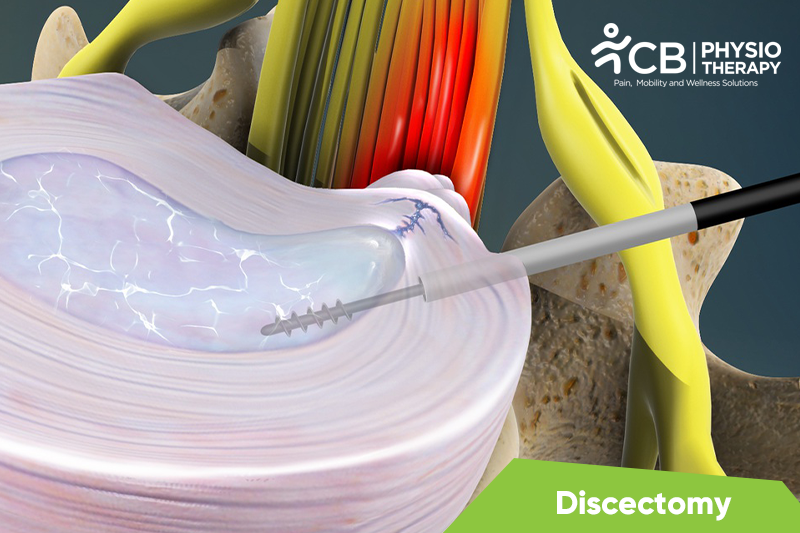
डिस्केक्टॉमी एक उभड़ा हुआ या हर्नियेटेड इंटरवर्टेब्रल डिस्क का हिस्सा या सभी का सर्जिकल निष्कासन है जो एक तंत्रिका जड़ या रीढ़ की हड्डी के खिलाफ दबाता है जिससे दर्द और अन्य लक्षण होते हैं। नरम ऊतक या हड्डी को हटाकर और स्पाइनल कैनाल की सामग्री को संकुचित करके अपघटन प्राप्त करने के लिए सर्जरी की जाती है। यदि हर्नियेटेड डिस्क पारंपरिक उपचार के लिए अनुत्तरदायी है तो दर्द को कम करने के लिए सर्जरी की जाती है।
डिस्केक्टॉमी के प्रकार:
<उल शैली = "सूची-शैली-प्रकार: डिस्क;">रूढ़िवादी प्रबंधन के प्रति अनुत्तरदायी रेडिकुलर दर्द के लिए डिस्केक्टॉमी का संकेत दिया जाता है इसलिए दर्द को कम करने और गतिशीलता और कार्य को पुनः प्राप्त करने के लिए सर्जरी की सिफारिश की जाती है। अन्य कारण हो सकते हैं:
<उल शैली = "सूची-शैली-प्रकार: डिस्क;">
पैथोलॉजी
रीढ़ या वर्टिब्रल कॉलम हड्डियों (कशेरुका) से बना होता है, जो एक के ऊपर एक टिका होता है अन्य। इन कशेरुकाओं के बीच में डिस्क होती हैं जो अपने कुशनिंग प्रभाव द्वारा सहायता प्रदान करती हैं और कशेरुक स्तंभ को झुकने की अनुमति भी देती हैं। हालांकि, जब डिस्क रोगग्रस्त हो जाती है, तो यह उभरी हुई या हर्नियेटेड हो सकती है, जिससे रीढ़ की नसों का संपीड़न होता है। यह गर्दन में स्थानीय दर्द, पीठ दर्द, या विकिरण दर्द का कारण बनता है, जैसे कटिस्नायुशूल जो एक या दोनों पैरों में फैलता है। ऐसे मामलों में, डिस्क को सर्जरी द्वारा निकालने की आवश्यकता होती है।
एक्स-रे:
एक्स-रे यह निर्धारित करने में मदद करते हैं कि हड्डी किस हद तक क्षतिग्रस्त हुई है।
MRI:
MRI डिस्क, हड्डी, मांसपेशियों या लिगामेंटस क्षति को निर्धारित करने में मदद करता है।
दवा: दर्दरोधी दवाएं, दर्दनिवारक, आदि।
नोट
कोल्ड थेरेपी का उपयोग ऐंठन और सूजन को कम करने के लिए किया जा सकता है।
रक्त परिसंचरण को बढ़ाने और विषाक्त पदार्थों को बाहर निकालने के लिए हीट थेरेपी दी जा सकती है।
ईएमएस:
कमजोर मांसपेशियों को मजबूत करने के लिए विद्युत मांसपेशी उत्तेजना की सिफारिश की जाती है।
ब्रेसिज़:
रोगी को ब्रेसेस पहनना जारी रखना चाहिए और कमर के बल झुककर फर्श से वस्तुओं को उठाने का विरोध करना चाहिए, भारी वस्तुओं को उठाने से बचना चाहिए।
चलना:
चलने से पूरे शरीर में रक्त का प्रवाह बढ़ता है और कार्डियोवैस्कुलर सहनशक्ति बनाने में मदद मिलती है। बढ़े हुए रक्त प्रवाह के कारण, रोगी को ठीक करने में मदद करने के लिए ऊतकों में अधिक पोषक तत्व और ऑक्सीजन लाए जाते हैं। चढ़ाई वाली सीढ़ियां रोजाना एक बार चढ़नी चाहिए। चलने से गतिशीलता जल्दी वापस पाने में मदद मिलती है और निशान ऊतक बनने की संभावना भी कम हो जाती है।
गति अभ्यास की सीमा:
गतिशीलता और कार्यक्षमता बनाए रखने के लिए गति अभ्यास की सरल रेंज की जाती है।
स्ट्रेंथनिंग एक्सरसाइज:< /a>
स्ट्रेंथेनिंग एक्सरसाइज़ का लक्ष्य रीढ़ को हल्का मज़बूती प्रदान करना और प्रत्येक दिन 30 मिनट कार्डियो के साथ रोगी की सहनशीलता में सुधार करना है। ये व्यायाम डिस्क के आसपास की मांसपेशियों को मजबूत करते हैं और लचीलापन भी बढ़ाते हैं। पीठ के निचले हिस्से की मांसपेशियों को लक्षित करने वाले स्नातक, दोहराए जाने वाले अभ्यासों के साथ ताकत हासिल की जाती है। प्रोन और सुपाइन लेग रेज पीठ के निचले हिस्से और पेट की मांसपेशियों के व्यायाम जैसे प्रोन लेग रेज, सुपाइन लेग रेज, स्पाइन फ्लेक्सर्स को मजबूत करने के लिए, छाती के व्यायाम के लिए घुटनों के वैकल्पिक व्यायाम किए जा सकते हैं, कोर की मांसपेशियों को मजबूत करने के लिए चपटा करना शामिल है। पीठ के निचले हिस्से को जमीन से छूने के लिए पीठ के बल लेटकर घुटनों को मोड़कर फिजियोथेरेपिस्ट की देखरेख में किया जाना चाहिए।
स्ट्रेचिंग एक्सरसाइज:
स्ट्रेचिंग व्यायाम मांसपेशियों की ऐंठन और कोमल ऊतक प्रतिबंधों को दूर करने में मदद करते हैं। व्यायाम में चलना, हल्का खिंचाव, मल्टीफिडी और ग्लूट सेट के साथ आइसोमेट्रिक्स, ट्रांसवर्स एब्डोमिनल ब्रेसिंग आदि शामिल हैं, ये व्यायाम लक्षित मांसपेशियों के लचीलेपन को बढ़ाते हैं।
आसन का रखरखाव:
फ़िज़ियोथेरेपिस्ट मुद्रा और चाल में सुधार करने में मदद करता है। स्नायुबंधन पर अतिरिक्त तनाव को रोकने के लिए और मांसपेशियों की सड़न को रोकने के लिए भी उचित मुद्रा आवश्यक है। शुरू में बैठने की मुद्रा कठिन हो सकती है, बैठने की अवधि शुरू में 20 मिनट हो सकती है, जिसे धीरे-धीरे बढ़ाया जा सकता है।
कार्डियो व्यायाम:
कार्डियो एक्सरसाइज में वॉकिंग प्रोग्रेस और स्थिर बाइक वर्कआउट शामिल है जबकि लाइट स्ट्रेंथनिंग एक्सरसाइज में ट्रांसवर्स एब्डोमिनल, ग्लूट एक्टिवेशन, और ऊपरी और निचले छोर को मजबूत बनाना। ऊपरी और निचले अंगों को मजबूत करने के लिए हाइड्रोथेरेपी भी दी जाती है।
फिजियोथेरेपी के बारे में हमारे विशेषज्ञों को खोजने और उनसे जुड़ने के लिए अपने शहर का चयन करें डिस्केक्टॉमी